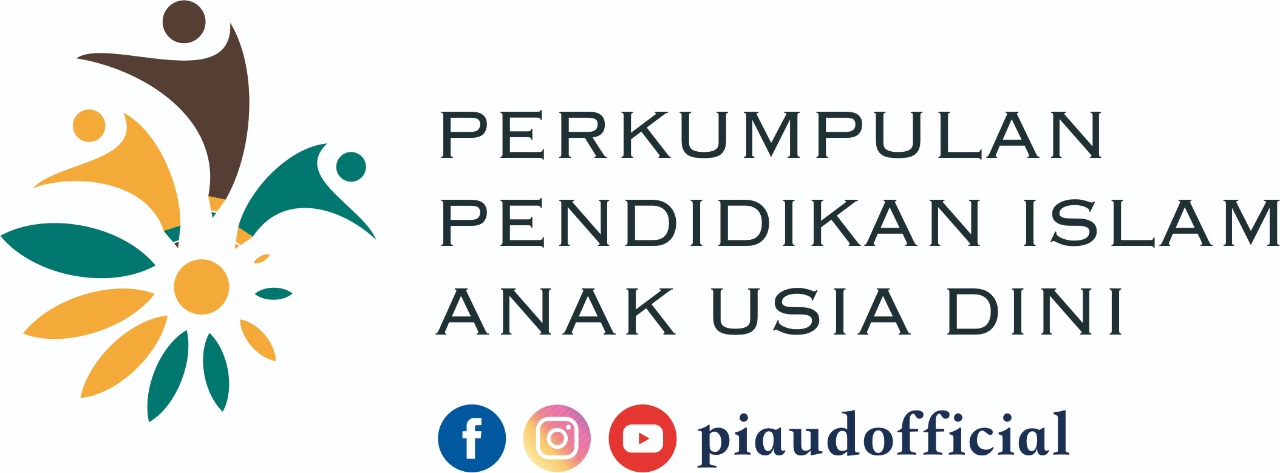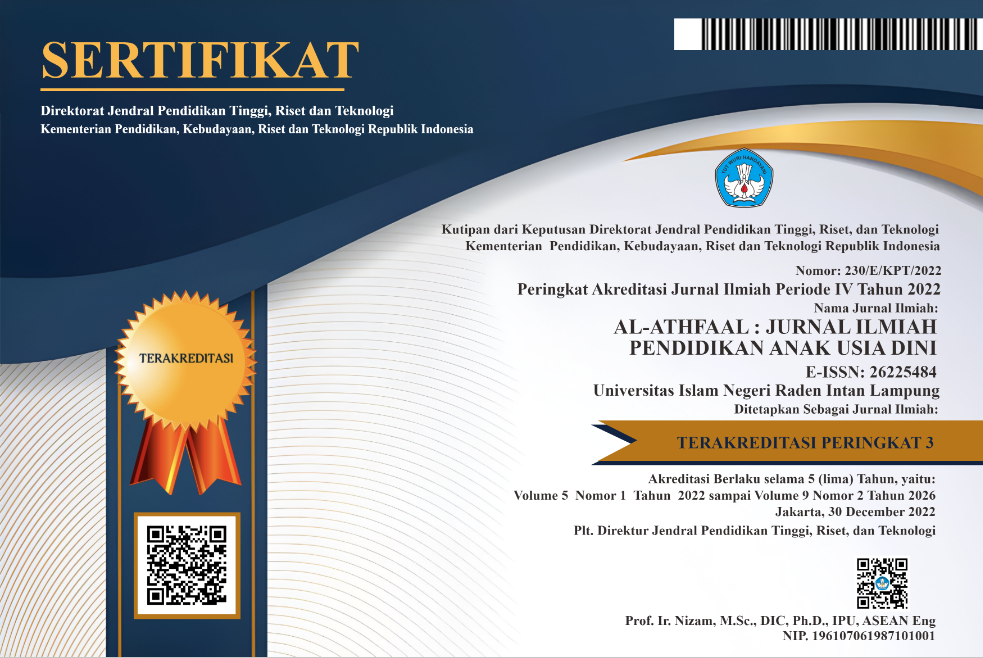Dampak Paparan Pornografi Pada Anak Usia Dini
Abstract
Pada abad 21, anak usia dini hingga manula sudah terbiasa dengan penggunaan teknologi, bahkan beberapa penelitian menjelaskan bahwa anak usia dua tahun saat ini sudah terbiasa menggunakan gadget untuk bermain game, membuka youtube atau membuka galeri video dengan sangat ahli. Oleh karena itu, artikel ini bertujuan untuk mengeksplorasi tentang kebiasaan penggunaan gadget pada anak usia dini dan kasus-kasus anak usia dini melihat video porno, mencari dampak anak melihat pornografi, dan penyebab anak usia dini terpapar video porno di era digital saat ini. Artikel ini menggunakan pendekatan kualitatif deskriptif dengan metode tinjauan literatur. Data dikumpukan dengan menganalisis beberapa kasus, jurnal, dokumen, data lain baik cetak maupun elektronik yang relevan. Hasil menunjukkan bahwa paparan pornografi pada anak dapat menyebabkan kerusakan otak, rusak kemampuan konsentrasi dan fokus, serta membuat anak kecanduan video porno, mengalami penyimpangan seks, hingga menjadi pelaku pelecehan atau kekerasan seksual di masa mendatang.
In the 21st century, children to adults are digital consumers to the use of technology, it even various studies explain that a lot of children in the age of two are now accustomed to using gadgets to play games, open YouTube or watch video from galleries with great expertise. The goal of this article study was to explore the habits of using gadgets in early childhood and cases of early childhood viewing porn videos, to analisys the impact of children watching pornography, and to find the causes of early childhood exposure to pornographic videos in today's digital era. This article contains used qualitative descriptive approach with library research method. The data were collected by analyzing some printed and electronic journals, books, documents, and other sources that related. These results indicated that exposure pornography in children can cause the brain demage, impaired concentration and focus ability, and become addicted to pornographic videos, experience sexual deviations, and become perpetrators of sexual harassment or violence in the future.
Keywords
Full Text:
PDFReferences
Abiala, K., & Hernwall, P. (2013). Tweens negotiating identity online - Swedish girls’ and boys’ reflections on online experiences. Journal of Youth Studies, 16(8), 951–969. https://doi.org/10.1080/13676261.2013.780124
American Psychological Association. (2007). Task Force on the Sexualization of Girls. In Report of the APA Task Force on the Sexualization of Girls.
Anggraini, Trinita. (2017). Pendidikan Seksual Anak Usia Dini : Aku dan Diriku. Jurnal Pendidikan Anak, 3 (2).
Anggraini, W., & Kuswanto, C. W. (2019). Teknik Ceklist Sebagai Asesmen Perkembangan Sosial Emosional di RA. Al-Athfaal: Jurnal Ilmiah Pendidikan Anak Usia Dini, 2(2), 61-70. https://doi.org/10.24042/ajipaud.v2i2.5248
Arrington-Sanders, R., Harper, G. W., Morgan, A., Ogunbajo, A., Trent, M., & Fortenberry, J. D. (2015). The Role of Sexually Explicit Material in the Sexual Development of Same-Sex-Attracted Black Adolescent Males. Archives of Sexual Behavior, 44(3), 597–608. https://doi.org/10.1007/s10508-014-0416-x
Asosiasi Penyelenggara Jasa Internet Indonesia. (2017). Infografis Penetrasi & Perilaku Pengguna Internet Indonesia: Survey 2017.
Ayuwuragil, K. (2018). Pengguna Internet Indonesia Capai 143 Juta. CNN Indonesia. https://www.cnnindonesia.com/teknologi/20180219160127-192-277197/pengguna-internet-indonesia-capai-143-juta
Bempah, R. T. (2018). Dipengaruhi Film Porno, 6 Bocah di Bawah Umur Diduga Setubuhi Gadis 8 Tahun. Kompas.Com. https://kilasdaerah.kompas.com/jawa-tengah/read/2018/03/05/13102921/dipengaruhi-film-porno-6-bocah-di-bawah-umur-diduga-setubuhi-gadis-8-tahun
Bulkley, M. (2013). Warning to parents: cyber-sex addiction is a teen issue. Family Bootcamp. http://familybootcamp.org/news/2013/11/1/warning-to-parents-cyber-sex-addiction-is-a-teen-issue
Dehmler, K. (2009). Adolescent technology usage during sleep-time: Does it influence their quality of sleep, attention difficulties and academic performance? [Rochester Institute of Technology]. In Rochester Institute of Technology. https://doi.org/http://dx.doi.org/10.2471/BLT.14.147231
Diana, I., & Meyritha, T. (2019). Studi Kasus Kecanduan Pornografi pada Remaja. Motiva, 1(1).
Direktorat Pembinaan Pendidikan Keluarga. (2017). Seri Pendidikan Orang Tua: Mendampingi Anak Menghadapi Bahaya Pornografi. Direktorat Pembinaan Pendidikan Keluarga.
Fagan, P. F. (2009). the Effects of Pornography on. Research Synthesis, December.
Febrino. (2017). Tindakan Preventif Pengaruh Negatif Gadget Terhadap Anak. Noura, 1(1), 1–2.
Flood, M. (2009). The Harms of Pornography Exposure Among Children and Young People. Child Abuse Review, 18(6), 384–400. https://doi.org/10.1002/car.1092
Graafland, J. H. (2018). New Technologies and 21st Century Children. OECD Education Working Papers, 179. https://doi.org/10.1787/e071a505-en
Greenfield, S. (2008). Modern technology is changing the way our brains work, says neuroscientist | Daily Mail Online. Daily Mail. https://www.dailymail.co.uk/sciencetech/article-565207/Modern-technology-changing-way-brains-work-says-neuroscientist.html
Gunawan, A. (2016). Pengaruh Kegiatan Matrikulasi Pendidikan Seks dan Kesadaran Tentang Bahaya Pornografi Terhadap Karakter Peserta Didik. Tsamrah Al-Fikri, 10(1), 155–172.
Hainstock, E. G., & Havis, L. (1997). Teaching Montessori in the Home: The Pre-School Years (p. 115). Plume.
Haryani R., M., Mudjiran, & Syukur, Y. (2012). Dampak Pornografi terhadap Perilaku Siswa dan Upaya Guru Pembimbing Untuk Mengatasinya. Konselor: Jurnal Ilmiah Konseling, 1(1), 1–8. https://doi.org/10.1016/j.jvolgeores.2007.11.022
Haryanto, A. T. (2020, February 20). Riset: Ada 175,2 Juta Pengguna Internet di Indonesia. Detikinet. https://inet.detik.com/cyberlife/d-4907674/riset-ada-1752-juta-pengguna-internet-di-indonesia
Kamaruddin, N., Rahman, A. W. A., & Handiyani, D. (2018). Pornography addiction detection based on neurophysiological computational approach. Indonesian Journal of Electrical Engineering and Computer Science, 10(1), 138–145. https://doi.org/10.11591/ijeecs.v10.i1.pp138-145
Kuswanto, C. W. (2016). Menumbuhkan Kemandirian Anak Usia Dini Melalui Bermain. Jurnal Ilmiah Pendidikan Islam Anak Usia Dini Darul Ilmi, 1(2).
Love, T., Laier, C., Brand, M., Hatch, L., & Hajela, R. (2015). Neuroscience of internet pornography addiction: A review and update. Behavioral Sciences, 5(3), 388–433. https://doi.org/10.3390/bs5030388
Malamuth, N., Donnerstein, E., & Smith, S. (2001). Research on sex in the media: what do we know about effects on children and adolescents? In D. G. Singer (Ed.), Handbook of Children and the Media (pp. 269–287). SAGE.
Miftahul Munir. (2018). Viral, Bocah Nonton Video Porno, Orang Tua Cuek. Akurat.Co. https://akurat.co/id-175111-read-viral-bocah-nonton-video-porno-orang-tua-cuek
Nahriyah, S. (2017). Tumbuh Kembang Anak Di Era Digital. Risalah: Jurnal Pendidikan Dan Studi Islam, 4(1), 65–74. https://doi.org/10.5281/zenodo.1227474
Novita, E. (2018). Faktor-Faktor yang Mempengaruhi Kebiasaan Menonton Film Porno pada Remaja. ANTHROPOS : Jurnal Antropologi Sosial Dan Budaya, 4(1), 31–44.
Ofcom. (2017). Children and Parents : Media Use and Attitudes Report.
Peter, J., & Valkenburg, P. M. (2007). Adolescents’ Exposure to a Sexualized Media Environment and Their Notions of Women as Sex Objects. Sex Roles, 56, 381–395. https://doi.org/10.1007/s11199-006-9176-y
Pranamya Dewati. (2018). Kemen PPPA Siap Beri Trauma Healing pada Anak yang Tonton Video Porno. Kumparan.Com. https://kumparan.com/@kumparannews/kemen-pppa-siap-beri-trauma-healing-pada-anak-yang-tonton-video-porno
Purwaningsih, S. W. (2018). Pemberdayaan Remaja untuk Mencegah Narkolema. Gemassika, 2(1).
Saint John Vianney Centre. (2018). Understanding The Effects Of Pornography. Saint John Vianney Centre.
Semai. (2015). Bahaya Pornografi : Merusak Otak. Youtube. https://www.youtube.com/watch?v=O9rMmjVa5QI
Sherwood, C. C., & Smaers, J. B. (2013). What’s the fuss over human frontal lobe evolution? In Trends in Cognitive Sciences (Vol. 17, Issue 9, pp. 432–433). Elsevier Current Trends. https://doi.org/10.1016/j.tics.2013.06.008
Sigman, A. (2017). Screen Dependency Disorders: a new challenge for child neurology. Journal of the International Child Neurology Association, 17(119), 1–13.
Simuforosa, M. (2013). The impact of modern technology on the educational attainment of adolescents. International Journal of Education and Research, 1(9), 1–8.
Smaers, J. B., Gómez-Robles, A., Parks, A. N., & Sherwood, C. C. (2017). Exceptional Evolutionary Expansion of Prefrontal Cortex in Great Apes and Humans. Current Biology, 27(5), 714–720. https://doi.org/10.1016/j.cub.2017.01.020
Strasburger, V. C., Jordan;, A. B., & Donnerstein, E. (2010). Harmful effects of media on children and adolescents. Pediatrics, 125(4). https://doi.org/10.1542/peds.2009-2563
Sundus, M. (2018). The Impact of using Gadgets on Children. S e s i r o p n e D a f n o d l A a n n r x i u e o t y J ISSN: 2167-1044 Journal of Depression and Anxiety, 7(1), 1–3. https://doi.org/10.4172/2167-1044.1000296
Suyatno, T. (2011). Pengaruh Pornografi Terhadap Perilaku Belajar Siswa. Jurnal Pendidikan Dompet Dhuafa, 1, 1–12.
Tim Sejiwa. (2018). Smart School Online: Hari-Hari Tanpa Pornografi. Smart School Online.
Verendeev, A., & Sherwood, C. C. (2017). Human Brain Evolution. In Current Opinion in Behavioral Sciences (Vol. 16, pp. 41–45). Elsevier Ltd. https://doi.org/10.1016/j.cobeha.2017.02.003
Walin, H., O’grady, S., & Xu, F. (2016). Curiosity and Its Influence on Children’s Memory.
Wartella, E., Rideout, V., Lauicella, A. R., & Connell, S. L. (2014). Revised Parenting in the Age of Digital Technology: A National Survey (Issue June).
Yutifa, H., Dewi, A. P., & Misrawati. (2015). Hubungan Paparan Pornografi Melalui Elektronik Terhadap Perilaku Seksual Remaja. Jom, 2(2).
DOI: http://dx.doi.org/10.24042/ajipaud.v3i1.6546
Refbacks
- There are currently no refbacks.
Copyright (c) 2020 Al-Athfaal: Jurnal Ilmiah Pendidikan Anak Usia Dini
License URL: https://creativecommons.org/licenses/by-sa/4.0
 All publications by Al-Athfaal: Jurnal Ilmiah Pendidikan Anak Usia Dini [p-ISSN: 2622-5484, e-ISSN: 2622-5182] are licensed under a Creative Commons Attribution-ShareAlike 4.0 International License.
All publications by Al-Athfaal: Jurnal Ilmiah Pendidikan Anak Usia Dini [p-ISSN: 2622-5484, e-ISSN: 2622-5182] are licensed under a Creative Commons Attribution-ShareAlike 4.0 International License.











